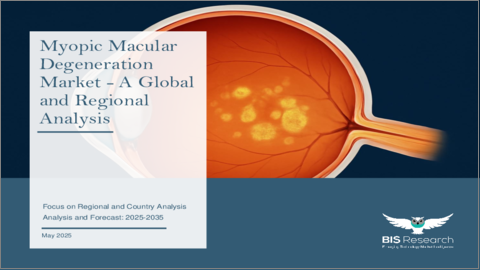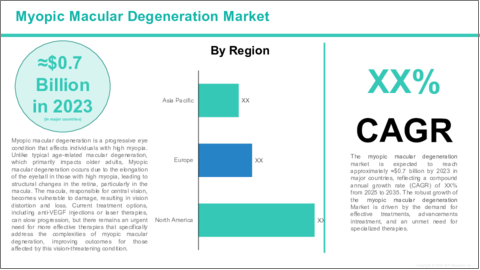|
|
市場調査レポート
商品コード
1735553
近視性黄斑変性症の世界市場:地域・国別の分析・予測 (2025~2035年)Myopic Macular Degeneration Market - A Global and Regional Analysis: Focus on Regional and Country Analysis - Analysis and Forecast, 2025-2035 |
||||||
カスタマイズ可能
|
|||||||
| 近視性黄斑変性症の世界市場:地域・国別の分析・予測 (2025~2035年) |
|
出版日: 2025年05月29日
発行: BIS Research
ページ情報: 英文 100 Pages
納期: 1~5営業日
|
全表示
- 概要
- 図表
- 目次
世界の近視性黄斑変性の市場は、高度近視の有病率の上昇、診断・治療ソリューションの進歩、高齢化の進行といった要因により、大きな成長を遂げています。
近視性黄斑変性に対する治療や介入の需要が高まる中で、この市場は視力障害に悩む患者の転帰を改善し、生活の質を維持する上で重要な役割を果たしています。本市場には、診断ツール、抗VEGF療法などの治療技術、視力喪失を管理するための支援技術などが含まれます。
近視性黄斑変性に対する早期診断・治療・合併症管理への継続的な注力は、この疾患に影響を受ける人々の増加に対応する上で極めて重要です。意識の向上、医療インフラの整備、治療オプションへのアクセス改善が市場の成長を後押ししています。
世界的な近視の発症率の上昇、特に都市部での増加は、近視性黄斑変性のリスク増加と直接的に関係しており、市場の大きな成長要因の一つとなっています。近視全体の増加傾向に加えて、高度近視の割合も上昇しています。調査によると、高度近視の患者数は中程度または軽度の近視よりも急速に増加しており、2050年までに高度近視の人口は世界で10億人を超える可能性があると予測されています。この増加は、近視性黄斑変性の症例数の増加と直結しています。
さらに、抗血管内皮増殖因子 (VEGF) 療法の開発は、近視性黄斑変性の治療環境に大きな影響を与えています。これらの治療法は、網膜内での異常な血管の成長を抑制することで、視力低下の主要因の一つに対処します。新しい抗VEGF治療薬や併用療法の承認は、治療の有効性を高め、アクセスを改善し、患者の治療成果を向上させています。
こうした前向きな成長の動きがある一方で、世界の近視性黄斑変性市場には依然としていくつかの課題が存在します。主な課題の一つは、治療費の高さです。これは、多くの患者、特に発展途上国や医療環境が整っていない地域の患者にとって、大きなアクセス障壁となっています。薬剤や手術を含む近視性黄斑変性の治療には高額な費用がかかるため、患者が必要な治療を受けられないケースがあり、市場の成長を妨げる要因となっています。また、他の疾患と予算を争う中で、医療制度が近視性黄斑変性の治療に十分な資金を割くことが難しいという現実もあります。
近視性黄斑変性市場が進化を続ける中で、今後の市場動向を形作ると期待される新たな動向として、より標的を絞った個別化治療の開発、早期発見と経過観察のためのデジタルヘルス技術の活用、予防と患者教育への関心の高まりなどが挙げられます。特に高齢化の進行や高度近視の有病率が高い地域における近視性黄斑変性の有病率の上昇により、よりアクセスしやすく、効果的で、かつ手頃な価格の治療法に対する需要が今後一層高まると予想されます。さらに、革新的な医薬品の開発、眼科用薬剤送達デバイス、手術技術の進歩への投資が増加しており、これらは今後数年間で主要な関係者にとって大きな成長機会をもたらすでしょう。
当レポートでは、世界の近視性黄斑変性症の市場を調査し、主要動向、市場影響因子の分析、法規制環境、臨床試験の動向、市場規模の推移・予測、各種区分・地域/主要国別の詳細分析、競合情勢、主要企業のプロファイルなどをまとめています。
目次
エグゼクティブサマリー
第1章 市場:業界展望
- 市場動向
- 規制の枠組み
- 近視性黄斑変性症の疫学
- 臨床試験分析
- 市場力学
- 影響分析
- 市場促進要因
- 市場の課題
- 市場機会
第2章 世界の近視性黄斑変性症市場:地域別
- 北米
- 欧州
- アジア太平洋
- 主な調査結果
- 市場力学
- 市場規模・予測
第3章 世界の近視性黄斑変性市場:競合情勢・企業プロファイル
- 主要な開発と戦略
- M&A
- 相乗的な取り組み
- 事業拡大と資金調達
- 製品の発売と承認
- その他の活動
- 企業プロファイル
- Regeneron Pharmaceuticals Inc.
- F. Hoffmann-La Roche Ltd
- Bayer AG.
第4章 調査手法
List of Figures
- Figure: Global Myopic Macular Degeneration Market, Dynamics Impact Analysis
- Figure: Epidemiology of Myopic Macular Degeneration
- Figure: Global Myopic Macular Degeneration Market Coverage
- Figure: Global Myopic Macular Degeneration Market Key Trends, Impact Analysis, 2023-2035
- Figure: Global Myopic Macular Degeneration Market, Competitive Landscape, January 2022-April 2025
List of Tables
- Table: Global Myopic Macular Degeneration Market, Clinical Trial Analysis,
- Table: Global Myopic Macular Degeneration Market Dynamics, Impact Analysis
- Table: Global Myopic Macular Degeneration Market (by Region), $Million, 2023-2035
Global Myopic Macular Degeneration Market, Analysis and Forecast: 2025-2035
The global myopic macular degeneration market is experiencing significant growth, primarily driven by the increasing prevalence of high myopia, advancements in diagnostic and therapeutic solutions, and a growing aging population. As demand for treatments and interventions for myopic macular degeneration rises, the market plays a crucial role in improving patient outcomes and maintaining the quality of life for individuals affected by vision impairment due to myopia-related complications. The myopic macular degeneration market encompasses diagnostic tools, therapeutic innovations like anti-VEGF therapies, and supportive technologies to manage vision loss.
The continued focus on early diagnosis, treatment, and managing complications from myopic macular degeneration is crucial in addressing the increasing number of individuals affected by this condition. Increased awareness, improved healthcare infrastructure, and enhanced accessibility to treatment options are fuelling the growth of this market.
One of the significant drivers of the global myopic macular degeneration market is the rising global incidence of myopia, particularly in urbanized regions, is directly contributes to a higher risk of developing myopic macular degeneration. Myopia in general is becoming more widespread, and the proportion of people developing high myopia is also on the rise. Research indicates that high myopia is growing more rapidly than moderate or low myopia, with estimates suggesting that the number of individuals with high myopia could increase to over 1 billion globally by 2050. This growing number directly correlates with a rise in myopic macular degeneration cases.
Moreover, the development of anti-vascular endothelial growth factor (VEGF) therapies has significantly impacted the treatment landscape for myopic macular degeneration. These therapies help in preventing the growth of abnormal blood vessels in the retina, addressing one of the key causes of vision loss in myopic macular degeneration. The approval of new anti-VEGF treatments and combination therapies enhances the effectiveness of interventions, making treatments more accessible and improving patient outcomes.
Despite the positive growth trajectory, several challenges continue to impact the global myopic macular degeneration market. One of the primary challenges is the high cost of treatments, which creates a barrier to accessibility for many patients, especially in developing countries or underserved regions. The high costs of both medication and surgeries related to myopic macular degeneration treatment can limit patient access, which in turn hampers the growth of the market. Healthcare systems are often challenged to allocate funds for myopic macular degeneration treatments, given the competitive pressures from other conditions that also demand funding.
Leading players in the global myopic macular degeneration market, such as Regeneron Pharmaceuticals Inc., F. Hoffmann-La Roche Ltd, and Bayer AG, are continuously innovating to improve the effectiveness and comfort of myopic macular degeneration products. These companies are investing heavily in research and development to introduce new, technologically advanced solutions that cater to market growth. With a strong emphasis on user-friendly and environmentally sustainable products, these companies are shaping the future of myopic macular degeneration while enhancing their market positions globally.
The competitive landscape of the global myopic macular degeneration market is diverse, with numerous players across different regions offering a wide range of products. Regional players and local manufacturers are expected to play an important role in the market's growth, especially as demand increases in emerging markets such as Asia-Pacific. As consumer preferences shift towards more discreet, comfortable, and affordable solutions, the myopic macular degeneration market will continue to evolve, fostering new opportunities for both established and emerging companies.
As the myopic macular degeneration (MMD) market continues to evolve, emerging trends such as the development of more targeted and personalized therapies, the increasing use of digital health technologies for early detection and monitoring, and the growing focus on prevention and patient education are expected to shape its future landscape. The rising prevalence of myopic macular degneration, especially in aging populations and regions with high myopia rates, will fuel demand for more accessible, effective, and affordable treatment options. Additionally, the increasing investment in innovative drug development, development of ophthalmic drug delivery devices, and surgical techniques will present significant growth opportunities for key stakeholders in the coming years.
In conclusion, the global myopic macular degeneration market is poised for steady growth, driven by advancements in treatment technologies, a growing awareness of the condition, and the ongoing efforts to enhance patient outcomes. As the need for specialized care increases, both global and regional players will continue to play a critical role in providing solutions to those affected by myopic macular degeneration, ultimately improving the quality of life for patients and ensuring better long-term eye health.
Table of Contents
Executive Summary
Scope and Definition
Market/Product Definition
Inclusion and Exclusion
Key Questions Answered
Analysis and Forecast Note
1. Markets: Industry Outlook
- 1.1 Introduction
- 1.2 Market Trends
- 1.3 Regulatory Framework
- 1.4 Epidemiology of Myopic Macular Degeneration
- 1.5 Clinical Trial Analysis
- 1.6 Market Dynamics
- 1.6.1 Impact Analysis
- 1.6.2 Market Drivers
- 1.6.3 Market Challenges
- 1.6.4 Market Opportunities
2. Global Myopic Macular Degeneration Market (Region), ($Million), 2023-2035
- 2.1 North America
- 2.1.1 Key Findings
- 2.1.2 Market Dynamics
- 2.1.3 Market Sizing and Forecast
- 2.1.3.1 North America Myopic Macular Degeneration Market, by Country
- 2.1.3.1.1 U.S.
- 2.1.3.1 North America Myopic Macular Degeneration Market, by Country
- 2.2 Europe
- 2.2.1 Key Findings
- 2.2.2 Market Dynamics
- 2.2.3 Market Sizing and Forecast
- 2.2.3.1 Europe Myopic Macular Degeneration Market, by Country
- 2.2.3.1.1 Germany
- 2.2.3.1.2 U.K.
- 2.2.3.1.3 France
- 2.2.3.1.4 Italy
- 2.2.3.1.5 Spain
- 2.2.3.1 Europe Myopic Macular Degeneration Market, by Country
- 2.3 Asia Pacific
- 2.3.1 Key Findings
- 2.3.2 Market Dynamics
- 2.3.3 Market Sizing and Forecast
- 2.3.3.1 Asia Pacific Myopic Macular Degeneration Market, by Country
- 2.3.3.1.1 Japan
- 2.3.3.1 Asia Pacific Myopic Macular Degeneration Market, by Country
3. Global Myopic Macular Degeneration Market: Competitive Landscape and Company Profiles
- 3.1 Key Development and Strategies
- 3.1.1 Mergers and Acquisitions
- 3.1.2 Synergistic Activities
- 3.1.3 Business Expansions and Funding
- 3.1.4 Product Launches and Approvals
- 3.1.5 Other Activities
- 3.2 Company Profiles
- 3.2.1 Regeneron Pharmaceuticals Inc.
- 3.2.1.1 Overview
- 3.2.1.2 Top Products / Product Portfolio
- 3.2.1.3 Top Competitors
- 3.2.1.4 Target Customers/End-Users
- 3.2.1.5 Key Personnel
- 3.2.1.6 Analyst View
- 3.2.2 F. Hoffmann-La Roche Ltd
- 3.2.2.1 Overview
- 3.2.2.2 Top Products / Product Portfolio
- 3.2.2.3 Top Competitors
- 3.2.2.4 Target Customers/End-Users
- 3.2.2.5 Key Personnel
- 3.2.2.6 Analyst View
- 3.2.3 Bayer AG.
- 3.2.3.1 Overview
- 3.2.3.2 Top Products / Product Portfolio
- 3.2.3.3 Top Competitors
- 3.2.3.4 Target Customers/End-Users
- 3.2.3.5 Key Personnel
- 3.2.3.6 Analyst View
- 3.2.1 Regeneron Pharmaceuticals Inc.





